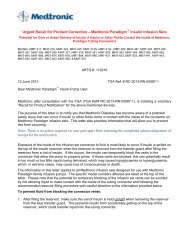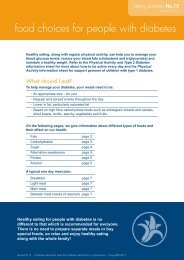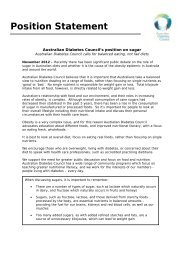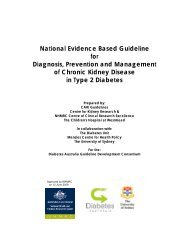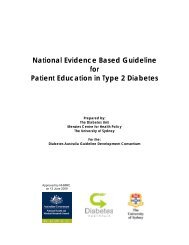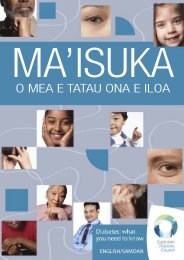Background - <strong>Foot</strong>wear to Reduce Ulceration <strong>and</strong> AmputationA pivotal or <strong>in</strong>itiat<strong>in</strong>g event commonly precedes the development <strong>of</strong> a foot ulcer orleads to an amputation (Pecoraro et al, 1990). This may be an acute traumatic event,such as stepp<strong>in</strong>g on a tack, or the result <strong>of</strong> abnormal pressure on the foot, such aswear<strong>in</strong>g new or ill fitt<strong>in</strong>g shoes or socks. Pressure ulcers, also called stress ulcers ormal perforans, frequently result from repetitive low-pressure stress <strong>of</strong> walk<strong>in</strong>g on anunprotected neuropathic foot, result<strong>in</strong>g <strong>in</strong> repeated friction over prom<strong>in</strong>ences such asa plantar callus. In addition they may result from <strong>in</strong>grown toenails or fromimmobilisation <strong>in</strong> a bed or chair. This <strong>in</strong>itiat<strong>in</strong>g event superimposed on an at risk foot(eg <strong>in</strong>sensate or with vascular <strong>in</strong>sufficiency) is <strong>of</strong>ten the critical factor which mayultimately lead to amputation (Mayfield et al, 1996).Apelqvist et al (1990) studied 314 consecutive people with diabetes <strong>and</strong> a foot ulcer<strong>and</strong> identified an acute traumatic precipitat<strong>in</strong>g event <strong>in</strong> 18%, ill fitt<strong>in</strong>g shoes or socks<strong>in</strong> 39%, mal perforans <strong>in</strong> 12%, paronychia <strong>in</strong> 6%, decubitus pressure <strong>in</strong> 5%, <strong>and</strong> noobvious precipitat<strong>in</strong>g event <strong>in</strong> 16%. In another study shoe trauma preceded ulceration<strong>in</strong> 47% <strong>of</strong> 386 ulcers <strong>in</strong> 239 people (Edmonds et al, 1986).Mayfield et al (1996) <strong>in</strong> a retrospective study <strong>of</strong> 61 diabetic Pima Indians withdiabetes who underwent an amputation identified trauma as the pivotal event <strong>in</strong> 44%(shoe trauma 8% <strong>of</strong> total) <strong>and</strong> new onset ulcer without trauma, many <strong>of</strong> which wereprobably mal perforans, <strong>in</strong> 39%.Elevated plantar pressure is causally related to the occurrence <strong>of</strong> foot ulcers <strong>in</strong> peoplewith diabetes with neuropathy (Veves et al, 1992). As well as expos<strong>in</strong>g the foot to<strong>in</strong>jury, barefoot walk<strong>in</strong>g is associated with higher foot pressures than wear<strong>in</strong>g shoes.In addition the type <strong>of</strong> footwear also has a significant <strong>in</strong>fluence on plantar pressures(Lavery et al, 1997; Kastenbauer et al, 1998).Tovey (1984) has detailed the desirable characteristics <strong>of</strong> appropriate diabeticfootwear aim<strong>in</strong>g to reduce shock <strong>and</strong> shear, <strong>and</strong> accommodate, stabilise <strong>and</strong> supportdeformities.• width to accommodate the first metatarsophalangeal jo<strong>in</strong>t• length should allow about 1cm between the end <strong>of</strong> the shoe <strong>and</strong> the longesttoe• depth to allow sufficient room <strong>in</strong> the toe area <strong>and</strong> <strong>in</strong>step• laces to adjust for oedema <strong>and</strong> deformities• snug fit <strong>of</strong> heel without undue motion• wide low heels to improve stabilityWear<strong>in</strong>g <strong>of</strong> <strong>in</strong>appropriate footwear is common <strong>in</strong> people with diabetes. Reiber et al(2002b) studied footwear <strong>in</strong> people with diabetes <strong>and</strong> a history <strong>of</strong> foot ulcer. A total <strong>of</strong>400 people (mean age 62 years) with diabetes <strong>and</strong> a history <strong>of</strong> healed full-thicknessfoot lesion, no foot deformities requir<strong>in</strong>g a custom shoe, <strong>and</strong> ability to walk one block<strong>and</strong> climb one flight <strong>of</strong> stairs daily were <strong>in</strong>cluded <strong>in</strong> this cross-sectional study. 58% <strong>of</strong>subjects were <strong>in</strong>sensate to the 10g mon<strong>of</strong>ilament. In general, women spent an average<strong>of</strong> 51% <strong>of</strong> their time <strong>in</strong> dangerous shoes def<strong>in</strong>ed as those with shallow or narrow toebox, no laces, open toes or heels, <strong>and</strong> a heel height plac<strong>in</strong>g extra pressure on the ball74
<strong>of</strong> the foot than men who spent 27% <strong>of</strong> their time wear<strong>in</strong>g dangerous shoes. Both men<strong>and</strong> women spent nearly 30% <strong>of</strong> their time <strong>in</strong> slippers, stock<strong>in</strong>gs <strong>and</strong> barefoot for theirregular activities.Custom made orthopaedic footwear is expensive, cost<strong>in</strong>g considerably more thanmanufactured footwear. In addition, acceptance <strong>and</strong> use <strong>of</strong> custom made orthopaedicfootwear is poor. A survey <strong>of</strong> 62,170 people with diabetes who were Medicarebeneficiaries <strong>in</strong> 3 American states found low utilisation <strong>of</strong> therapeutic footwear. Ofthe 13% who fell <strong>in</strong>to the “high risk” group, only 2.9% claimed for footwear <strong>and</strong> <strong>of</strong>the 14% with possibly <strong>in</strong>creased risk, claims were made by only 0.7% (Sugarman etal, 1998). Other authors also report low levels <strong>of</strong> compliance with therapeuticfootwear, <strong>of</strong>ten related to the appearance <strong>of</strong> the footwear (Chantelau & Haage, 1994;McCabe et al, 1998). In contrast, specially designed, extra depth, extra width shoeswith a rocker bottom were well accepted by 24 male Veterans with 88% compliance(Reiber et al, 1997).The studies reviewed <strong>in</strong> this Section have used a variety <strong>of</strong> footwear <strong>and</strong>/or <strong>in</strong>soles<strong>and</strong>/or socks. The term “therapeutic footwear” has mostly been used <strong>in</strong> studies to referto the use <strong>of</strong> specially manufactured shoes or to the use <strong>of</strong> casts (total or half,removable or non-removable). A variety <strong>of</strong> <strong>in</strong>soles, either customised or not, <strong>and</strong>made <strong>of</strong> a variety <strong>of</strong> materials have been studied.Evidence – <strong>Foot</strong>wear to Reduce Ulceration <strong>and</strong> AmputationTherapeutic footwear reduces the risk <strong>of</strong> ulcer recurrenceMason et al (1999) performed a systematic review <strong>of</strong> diabetic foot ulcer preventionstrategies <strong>and</strong> identified only 1 r<strong>and</strong>omised trial (Uccioli et al, 1995) on the effect <strong>of</strong>therapeutic footwear. Although this study showed a beneficial effect, Mason et al(1999) recommended confirmatory studies on larger numbers <strong>of</strong> people with diabeteswith comparisons <strong>of</strong> ‘optimised’ normal shoes <strong>and</strong> special therapeutic shoes toconfirm the relative effectiveness <strong>and</strong> cost-effectiveness <strong>of</strong> wear<strong>in</strong>g therapeutic shoes.The study by Uccioli et al (1995) was a multicentre, RCT which assessed therapeuticfootwear <strong>and</strong> ulcer recurrence <strong>in</strong> people with previous foot ulcers. Manufacturedtherapeutic shoes were designed accord<strong>in</strong>g to Tovey’s guidel<strong>in</strong>es as previouslydescribed. Customised <strong>in</strong>soles were also provided. <strong>Foot</strong> ulcer relapses weresignificantly lower <strong>in</strong> the group <strong>of</strong> 33 wear<strong>in</strong>g therapeutic shoes compared with thecontrol group <strong>of</strong> 36 wear<strong>in</strong>g their own shoes (27.7% v 58.3%, OR 0.26, CI 0.2-1.54;p=0.0009). In multiple regression analysis adjusted for severity <strong>of</strong> disease, age <strong>and</strong>sex, the use <strong>of</strong> therapeutic shoes was negatively associated with foot ulcer relapse(coefficient <strong>of</strong> variation - 0.32, CI -0.54 to -0.08; p=0.009).A cohort <strong>of</strong> 51 people with diabetes were provided with protective footwear,cushioned with <strong>in</strong>soles after heal<strong>in</strong>g <strong>of</strong> a neuropathic foot ulcer <strong>and</strong> followed for up to4 years (Chantelau & Haage, 1994). In those who wore the protective footwear for>60% <strong>of</strong> daytime hours, ulcer recurrence was reduced by 50% (p=0.0002) comparedwith those who wore their footwear less frequently. After 2 years, the protective effectwore <strong>of</strong>f, suggest<strong>in</strong>g that footwear needed adaptation <strong>and</strong> renewal with<strong>in</strong> this time75
- Page 1:
National Evidence Based Guidelinesf
- Page 4:
Research OfficersMs Linda SmithPodi
- Page 7 and 8:
2.2 Issues for Foot Problems in Typ
- Page 9:
• Aim to achieve the best possibl
- Page 12 and 13:
Background - Peripheral Neuropathy
- Page 14 and 15:
proportion of subjects with a durat
- Page 16 and 17:
and an OR 1.1-7.8. This study also
- Page 18 and 19:
Summary - Peripheral Neuropathy as
- Page 20 and 21:
Section 2: Diabetes Foot ProblemsIs
- Page 22 and 23:
predicting risk of amputation, 2.9
- Page 24 and 25: Summary - Peripheral Vascular Disea
- Page 26 and 27: Section 3: Diabetes Foot ProblemsIs
- Page 28 and 29: Evidence - Foot Deformity and Previ
- Page 30 and 31: people with both LJM and neuropathy
- Page 32 and 33: Summary - Foot Deformity and Previo
- Page 34 and 35: Section 4: Diabetes Foot ProblemsIs
- Page 36 and 37: Also in the Seattle study, 67 peopl
- Page 38 and 39: Summary - Ulcer as a Risk Factor fo
- Page 40 and 41: Section 5: Diabetes Foot ProblemsIs
- Page 42 and 43: The other frequently reported metho
- Page 44 and 45: side; and 82% having the same resul
- Page 46 and 47: Evidence Table: Section 5Detection
- Page 48 and 49: Background - Clinical Detection of
- Page 50 and 51: pulse was bilaterally absent in 1.8
- Page 52 and 53: Evidence Table: Section 6AuthorClin
- Page 54 and 55: Background - Frequency of Foot Exam
- Page 56 and 57: Summary - Frequency of Foot Examina
- Page 58 and 59: Section 8: Diabetes Foot ProblemsIs
- Page 60 and 61: Behaviour assessment scores, measur
- Page 62 and 63: Mazzuca et al (1986) studies 532 pe
- Page 64 and 65: with before the programme, after 1-
- Page 66 and 67: Evidence Table: Section 8AuthorEffe
- Page 68 and 69: Background - Glycaemic Control and
- Page 70 and 71: In a previous Japanese randomised s
- Page 72 and 73: Evidence Table: Section 9AuthorGlyc
- Page 76 and 77: period. In addition people without
- Page 78 and 79: Comparisons of in-shoe foot pressur
- Page 80 and 81: The rate of plantar callus formatio
- Page 82 and 83: Evidence Table: Section 10AuthorFoo
- Page 84 and 85: Background - Foot Clinics and Multi
- Page 86 and 87: A prospective non randomised contro
- Page 88 and 89: Summary - Foot Clinics and Multi-di
- Page 90 and 91: Section 12: Diabetes Foot ProblemsI
- Page 92 and 93: and/or osteomyelitis; III - fore-fo
- Page 94 and 95: Summary - Economic consequences•
- Page 96 and 97: Section 13: Diabetes Foot ProblemsI
- Page 98 and 99: Some ethnic groups are associated w
- Page 100 and 101: Evidence Table: Section 13AuthorSoc
- Page 102 and 103: Calle-Pascual AL, Duran A, Diaz A,
- Page 104 and 105: Jannink MJ, van Dijk H, de Vries J,
- Page 106 and 107: Moss SE, Klein R, Klein BE. The 14-
- Page 108 and 109: Soulier SM, Godsey C, Asay ED, Perr
- Page 110 and 111: Diabetes Foot Problems: General Ref
- Page 112 and 113: McNeely MJ, Boyko EJ, Ahroni JH, St
- Page 114 and 115: Diabetes Foot Problems: Other Refer
- Page 116 and 117: Caputo GM, Cavanagh PR, Ulbrecht JS
- Page 118 and 119: Garbalosa JC, Cavanagh PR, Wu G, Ul
- Page 120 and 121: Lavery LA, Armstrong DG, Wunderlich
- Page 122 and 123: Payne C. Regional variations of dia
- Page 124 and 125:
Tovi J, Svanborg E, Nilsson BY, Eng
- Page 126 and 127:
Criteria used to determine the suit
- Page 128 and 129:
QUESTIONS KEY WORDS NO.ARTICLESIDEN
- Page 130 and 131:
QUESTIONS KEY WORDS NO.ARTICLESIDEN
- Page 132 and 133:
QUESTIONS KEY WORDS NO.ARTICLESIDEN
- Page 134 and 135:
QUESTIONS KEY WORDS NO.ARTICLESIDEN
- Page 136 and 137:
QUESTIONS KEY WORDS NO.ARTICLESIDEN
- Page 138 and 139:
QUESTIONS KEY WORDS NO.ARTICLESIDEN






